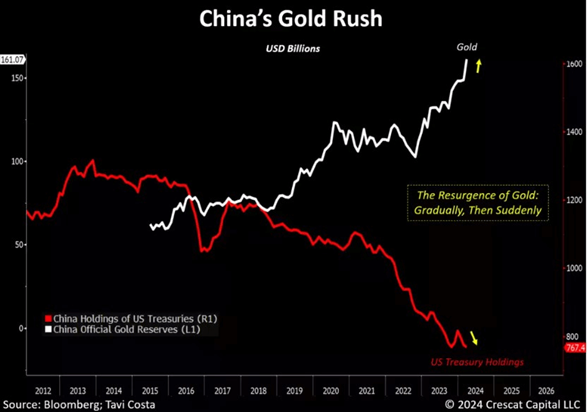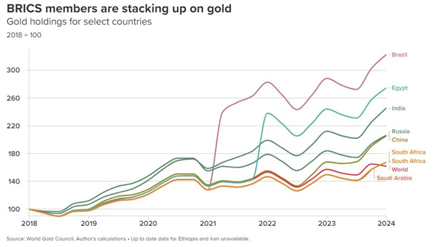China’s Xi speaks with Trump by phone, discusses Taiwan and bilateral ties
While the recent Geneva trade agreement signalled an easing in US-China trade tensions, Beijing continues to quietly pursue a deeper strategic shift, building gold reserves and promoting the yuan to reduce dollar dependence and reshape the global monetary landscape on its own terms.
As global power dynamics shift, China is steadily advancing a long-term financial strategy aimed at reshaping the international monetary order. Central to this effort is a decisive move away from the US dollar, a currency that has dominated global trade, reserves, and finance for nearly a century. In its place, China is betting on a dual foundation: gold and the yuan.
This strategy is not driven by ideology alone, but by pragmatism. Holding trillions in dollar-denominated assets has long made China vulnerable to US financial pressure, sanctions, and market volatility. By accumulating massive gold reserves and quietly internationalising the yuan through initiatives like the Shanghai Gold Exchange, Beijing is building a parallel financial architecture, one that enhances its autonomy while reducing exposure to the dollar-centric system.
Rather than provoking direct confrontation, China’s approach is calculated, gradual, and deeply strategic. Gold serves not only as a hedge against currency risk but as a symbol of monetary sovereignty. Meanwhile, the yuan, still constrained by capital controls, is gaining legitimacy through trade and bilateral agreements. Together, gold and the yuan are emerging as pillars of a broader Chinese ambition: to assert greater influence in global finance on its own terms.
Moving Away from the Dollar
For decades, China has maintained significant holdings of US Treasuries, once peaking at over $1.3 trillion. But in recent years, Beijing has been slowly unwinding this position. By Q1 2025, China held approximately $759 billion in US debt, reflecting a broader strategy of diversifying its reserves. In parallel, its gold holdings have risen sharply, reaching 2,292.31 tonnes, now accounting for 6.5% of its total official reserves.
This pivot is not merely a matter of portfolio balance. Gold is seen by Chinese policymakers as a strategic asset that offers insulation from geopolitical risks, especially US sanctions and financial coercion. The idea, echoed in a 2009 US Embassy cable released by WikiLeaks, is that the West has long suppressed gold prices to maintain dollar supremacy.
According to the cable, "China’s increased gold reserves will thus act as a model and lead other countries towards reserving more gold. Large gold reserves are also beneficial in promoting the internationalisation of the RMB."
Some analysts believe China’s actual gold holdings far exceed official numbers. Reports suggest the People’s Bank of China (PBoC) may be buying five times more gold than it discloses to the IMF, with real reserves potentially surpassing 5,000 tons. This opacity is deliberate—by quietly shifting reserves from dollars into gold, China avoids alarming markets while progressively building leverage.

What makes this strategy effective is its subtlety. Unlike dumping Treasuries, which could trigger market panic and backfire economically, buying gold is a quiet, cumulative tactic. It exerts downward pressure on the dollar over time, especially if other nations follow suit. By transforming some of its surplus dollars into gold, China reduces global demand for the greenback while building a monetary buffer that reflects real value.
Moreover, gold provides China with strategic optionality. It can be mobilised in times of currency instability, geopolitical shock, or trade disruption, without relying on dollar liquidity. In a system still dominated by the US currency, this kind of flexibility is powerful.
Stabilisation, Symbolism, and Strategy
Beyond weakening the dollar, China’s gold policy plays a central role in managing and projecting the strength of the yuan. As global interest in de-dollarisation grows, especially among countries subject to Western sanctions, China is positioning the renminbi as a viable alternative, and gold is a key part of this effort.
Domestically, the People’s Bank of China uses gold purchases to help stabilise the yuan, particularly during periods of external stress such as escalating tariffs or capital outflows. The recent tariff war, reignited in 2025 under President Trump with tariffs reaching 145% on Chinese imports and 125% retaliatory tariffs from China, exposed the fragility of trade-linked monetary flows. In May 2025, a temporary 90-day deal reduced tariffs to 30% and 10%, respectively.
Even in this reprieve, the yuan remained under pressure.
Internationally, China promotes yuan-denominated gold trading through platforms like the Shanghai Gold Exchange. This not only strengthens China’s influence over regional gold pricing but also encourages trading partners to settle transactions in yuan. In doing so, it boosts the currency’s credibility without the need to fully liberalise it.
The symbolic dimension of gold also matters. While fiat currencies are backed by trust in government policy, gold is seen as universally valuable, immune to manipulation. By tying its monetary policy closer to gold, China appeals to countries and institutions wary of US monetary dominance and the perceived weaponisation of the dollar.
The potential for a partially gold-backed yuan is often discussed, particularly in alternative financial circles. While a fully gold-backed currency is impractical given global trade volumes and limited gold supply, a hybrid system that enhances the yuan’s appeal via gold reserves is not beyond reach.
It would be especially attractive to nations in the Global South or sanctioned states like Russia and Iran, which are increasingly turning to alternative clearing systems and bilateral trade agreements.

Treasury Sales and De-dollarisation
While China’s pivot to gold is quiet and calculated, the idea of weaponising its US Treasury holdings is more explosive and controversial. With hundreds of billions still held in American debt, China theoretically holds leverage over US financial markets. Some speculate that, in times of high tension, Beijing could suddenly sell off Treasuries to destabilise the dollar.
Indeed, during the 2025 escalation of the US-China trade war, some analysts noted signs that China may have begun selling Treasuries. Yields on long-term US bonds surged in early April, prompting speculation that Beijing was subtly retaliating against Trump’s new wave of tariffs. However, data from Bloomberg and analysts at TD Securities suggest otherwise. If China were truly offloading its holdings, short-term yields should have spiked as well, but they didn’t.
Even if China has the capability, the risks of dumping Treasuries are substantial. Such a move would drive down the value of China’s remaining dollar-denominated assets and strengthen the yuan, making Chinese exports more expensive and threatening domestic growth.
As Treasury Secretary Scott Bessent noted in April 2025, selling Treasuries would ultimately hurt China’s own economic interests. "If they sell Treasuries, then they would have to buy RMBs, and it would strengthen their currency. And they’ve been doing just the opposite," he said.
The message from Chinese policymakers seems clear: financial confrontation with the US is not the goal. Beijing prefers to erode dollar dominance gradually, through market mechanisms and strategic diversification, not financial shock therapy.
A Gold-Backed Yuan?
Among the boldest ideas circulating is the possibility that China might eventually roll out a gold-backed digital yuan. Such a move would signal a dramatic shift in global finance, the return of a currency linked to a physical commodity but updated for the blockchain era.
While the symbolic impact would be enormous, the practical hurdles remain daunting. A gold-backed currency would constrain monetary policy, reduce flexibility in times of crisis, and require immense reserves to back even a modest share of the yuan in circulation. Additionally, the yuan still operates under strict capital controls, limiting its liquidity and convertibility.
Nonetheless, even without formal backing, China’s growing gold stockpile enhances confidence in the yuan. It signals discipline, stability, and long-term vision, qualities often lacking in fiat regimes that rely heavily on quantitative easing or debt monetisation. For countries looking to diversify away from the dollar, a gold-supported yuan, even unofficially, may become an increasingly attractive alternative.
Moreover, countries like Russia, Iran, and others facing Western sanctions have already increased gold and yuan usage in bilateral trade. As digital currencies evolve and central bank digital currencies (CBDCs) gain traction, a yuan with strong gold backing could play a leading role in an emerging multipolar financial system.
Conclusion
China’s monetary evolution is not a revolution, but a rebalancing. Through calculated gold accumulation and the slow elevation of the yuan in global trade, Beijing is building leverage, not detonating it. The aim is not to topple the dollar overnight, but to reduce exposure, hedge against financial coercion, and quietly offer the world another option.
Gold is more than a hedge in this strategy; it is a diplomatic tool, a stabiliser, and a message to the international community. Coupled with a disciplined, state-controlled currency, it allows China to challenge the dollar-based order without destabilising its own economy or inviting retaliation.
The world may not be ready to abandon the dollar, but it is increasingly prepared to consider alternatives. As inflation, sanctions, and debt reshape global finance, China’s gold-and-yuan strategy positions it not just as a rival to US economic power, but as an architect of the next monetary era, a system less reliant on trust and more grounded in value.
Whether that transition accelerates or unfolds over decades, one thing is clear: China is no longer just a participant in the global financial system—it is quietly rewriting its rules.
